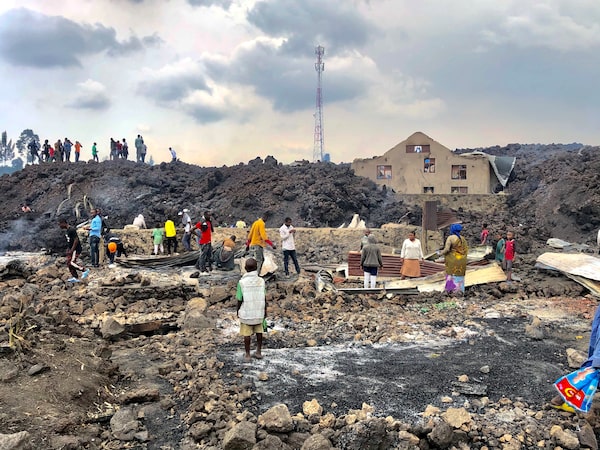
People gather on a stream of cold lava rock following the overnight eruption of Mount Nyiragongo near Goma, Congo, on May 23, 2021.Clarice Butsapu/The Associated Press
A smoking trail of lava from a volcanic eruption covered hundreds of houses in eastern Congo on Sunday, leaving residents to pick gingerly through the wreckage for belongings and loved ones, though the flow halted just short of the city of Goma.
Goma was thrown into panic on Saturday evening as Mount Nyiragongo, one of the world’s most active and dangerous volcanoes, erupted, turning the night sky an eerie red and sending a wall of orange lava downhill towards the lakeside city of about two million people.
Army spokesman Guillaume Njike said 13 were killed fleeing the disaster, including nine in a traffic accident and four who tried to escape Munzenze prison in Goma.
That figure will likely rise considerably. A Reuters reporter saw two people killed by the initial eruption in a village north of Goma, and witnesses spoke of dead and missing relatives.
Haunted by memories of an eruption in 2002 that killed 250 people and left 120,000 homeless, residents fled on foot with their belongings, some towards the nearby border with Rwanda.
The International Federation of Red Cross said that between 3,000 and 5,000 fled into Rwanda on Saturday, many of them peasants and farmers with livestock. Some began returning on Sunday.
The eruption was caused when fractures opened in the volcano’s side, causing lava flows in various directions.
As the sun rose on Sunday a smouldering black gash about half a mile wide could be seen on the outskirts of Goma, where the lava had cooled to rubble.
At some points it was three storeys high, engulfing even large buildings and sending smoke into the grey morning sky.
Residents in the Buhene district sorted through the mangled white remains of tin roofs or lifted rocks – tiny individual efforts in what will likely be a months-long campaign to restore the zone.
Elsewhere, groups of people posed for photos on the steaming lava.
Some said they had lost family members.
Ernestine Kabuo, 68, said she had tried to carry her sick husband from their house as the lava approached, but he was too unwell to leave.
“I said to myself, I can’t go alone, we’ve been married for the best and for the worst,” said Kabuo, walking in a daze and crying, surrounded by buildings swallowed by lava.
“I went back to at least try to get him out but couldn’t. I ran away and he got burned inside. I don’t know what to do. I curse this day.”
The flow towards Goma stopped a few hundred metres from the city limits. The nearby airport was untouched. A separate lava flow that headed east over unpopulated terrain towards Rwanda also appeared to have stopped.
“Local authorities who have been monitoring the eruption overnight report that the lava flow has lost intensity,” government spokesman Patrick Muyaya said on Twitter on Sunday.
Still, authorities warned that the danger was not over and that seismic activity in the area could cause further lava flows.
Lava crossed a main road out of Goma overnight, cutting it off from cities to the north. Traffic was in gridlock in most places as people tried to leave or return to assess the damage to their homes.
Experts were worried that the volcanic activity observed in the past five years at Nyiragongo mirrors that in the years preceding eruptions in 1977 and 2002.
Volcanologists at the OVG, which monitors Nyiragongo, have struggled to make basic checks on a regular basis since the World Bank cut funding amid embezzlement allegations.
From October 2020 to April, the observatory could not carry out comprehensive seismic checks on the volcano because analysts lacked an internet connection, OVG’s scientific director Celestin Kasereka Mahinda told local Radio Okapi on Sunday.
Internet was restored in April thanks to funding from a U.S. partner, he said, but by that stage too much time had been lost.
“As soon as the internet was restored, we had started recording the warning signals, but since we did not have previous data, we thought it was the start of volcanic activity. Hence this surprise.”
Our Morning Update and Evening Update newsletters are written by Globe editors, giving you a concise summary of the day’s most important headlines. Sign up today.